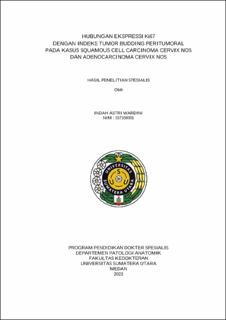| dc.contributor.advisor | Alferraly, T Ibnu | |
| dc.contributor.advisor | Chrestella, Jessy | |
| dc.contributor.author | Wardini, Indah Astri | |
| dc.date.accessioned | 2024-08-19T05:26:07Z | |
| dc.date.available | 2024-08-19T05:26:07Z | |
| dc.date.issued | 2023 | |
| dc.identifier.uri | https://repositori.usu.ac.id/handle/123456789/95661 | |
| dc.description.abstract | Background:
Cervical cancer is a malignant neoplasm of the cervix due to abnormal cell growth that damages the surrounding tissue derived from squamous epithelial cells called squamous cell carcinoma cervix NOS and derived from glands called adenocarcinoma cervix NOS, to determine the prognostic in both cases can be assessed by peritumoral budding tumors and Ki67 immunohistochemical staining where there are several studies in comparing peritumoral budding tumors and Ki67 immunohistochemical staining. peritumoral budding tumor can be used as a substitute for Ki67 immunohistochemistry in the determination of independent prognostic factors in both cases.
Method:
Squamous cell carcinoma and adenocarcinoma NOS were identified by an analytical analysis using 36 paraffin block samples at HAM Hospital. Medan. The link between Ki67 expression and peritumoral budding tumors in cases of cervical squamous cell carcinoma NOS and cervical adenocarcinoma NOS is evaluated, and the score for Ki67 expression is calculated, with low expression equaling < 20% and high expression equaling ≥ 20%. In both cases, the evaluation of peritumoral budding tumors was described as low buds if < 5 buds and high buds if ≥ 5 buds.
Results:
The correlation Ki67 expression with peritumoral budding tumors index in the cases of squamous cell carcinoma cervix NOS and cervical adenocarcinoma NOS that the lower expression of Ki67 then even lower grade of budding tumor peritumoral and conversely the higher expression of Ki67 then even higher grade of the budding tumor peritumoral.
Conclusion:
An anatomic pathologist may employ peritumoral budding tumor assessment to identify the prognosis of squamous cell carcinoma NOS and cervical adenocarcinoma NOS in circumstances where Ki67 immunohistochemistry is not feasible. | en_US |
| dc.language.iso | id | en_US |
| dc.publisher | Universitas Sumatera Utara | en_US |
| dc.subject | Squamous Cell Carcinoma Cervix NOS | en_US |
| dc.subject | Adenocarcinoma Cervix NOS | en_US |
| dc.subject | Peritumoral Budding Tumor | en_US |
| dc.subject | Immunohistochemistry Ki67 | en_US |
| dc.subject | SDGs | en_US |
| dc.title | Hubungan Ekspressi Ki67 dengan Indeks Tumor Budding Peritumoral pada Kasus Squamous Cell Carcinoma Cervix NOS dan Adenocarcinoma Cervix NOS | en_US |
| dc.title.alternative | Corellation Ki67 Expression with Peritumoral Budding Tumor Index in the Case of Squamous Cell Carcinoma Cervix NOS and Adenocarcinoma Cervix NOS | en_US |
| dc.type | Thesis | en_US |
| dc.identifier.nim | NIM197108001 | |
| dc.identifier.nidn | NIDN0012026205 | |
| dc.identifier.nidn | NIDN0013018201 | |
| dc.identifier.kodeprodi | KODEPRODI11754#Patologi Anatomik | |
| dc.description.pages | 94 Pages | en_US |
| dc.description.type | Tesis Magister | en_US |


